How long to air fry frozen spring rolls? Spring rolls take 7-8 minutes in an air fryer preheated to 400F (200C). Crispy air fryer frozen spring rolls are a fast appetizer or snack that the whole family loves, with no messy clean up! Use the directions for this easy air fryer recipe for Ling Ling spring rolls, Costco, Trader Joe’s, or your favorite brand.
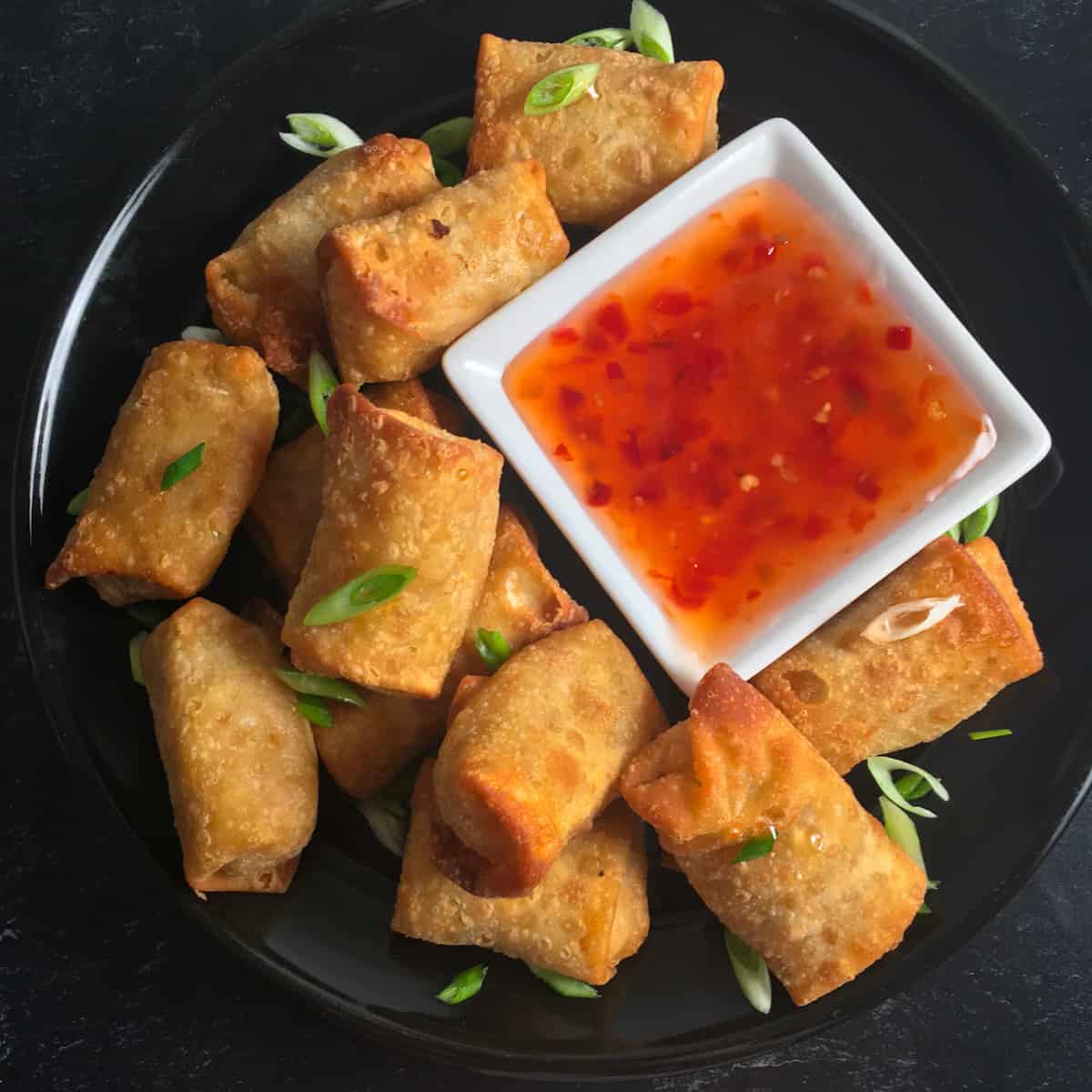
Want to save this post?
Enter your email below and we'll send it straight to your inbox. Plus you'll get great new recipes from us every week!
If egg rolls and spring rolls are your favorites when you get takeout Chinese food, today’s post is for you. We’re making air fryer spring rolls, an easy method for cooking spring rolls from frozen.
Before we begin though, I wanted to discuss the differences between egg rolls versus spring rolls.
Spring rolls typically have a thin wrapper made of rice paper or flour. Spring rolls may be served fresh, baked, or fried.
Egg rolls have a doughy wrapper that may or may not contain egg. Egg rolls are typically fried.
Lumpia is the name for a type of spring roll found in the Philippines and Indonesia. It may be served fresh or fried, and has an assortment of meat and vegetable fillings.
Because they are all so similar, you can use the recipe below to air fry frozen lumpia, make frozen mini spring rolls in air fryer, or cook frozen egg rolls. Just make sure to start with small frozen rolls (not the big, thick egg rolls).
If the spring rolls or lumpia look dry, you can mist them with cooking spray. Otherwise, skip it.
So, grab your favorite frozen spring rolls from Costco or another store, and let’s do this. This is the best way to cook frozen spring rolls and make them crispy, golden brown, and delicious!
Table of Contents
- ⭐ Ling Ling Spring Rolls (Air Fryer)
- ➕ How to Make Frozen Spring Rolls (Air Fryer)
- ⏲️ How long to cook mini spring rolls in air fryer?
- How to Reheat Spring Rolls in Air Fryer
- 💭 Are frozen spring rolls healthy?
- 👨🏾🍳 Other Air Fryer Appetizer Recipes
- 📖 Recipe Card
- 💭 Expert Tips from Dietitian Summer Yule
- Homemade Spring Rolls Recipe
- FAQs
- 💬 Comments
⭐ Ling Ling Spring Rolls (Air Fryer)
Here’s what you need to make frozen spring rolls in an air fryer:
- Ling Ling mini spring rolls (or use mini egg rolls)
- Cooking oil spray
- Your favorite dipping sauce
Get a printable recipe card at the end of the post!
The brand you use can impact the results of this recipe. Fat egg rolls and spring rolls will have a longer cooking time. This recipe works best with cocktail-size spring rolls or mini egg rolls.
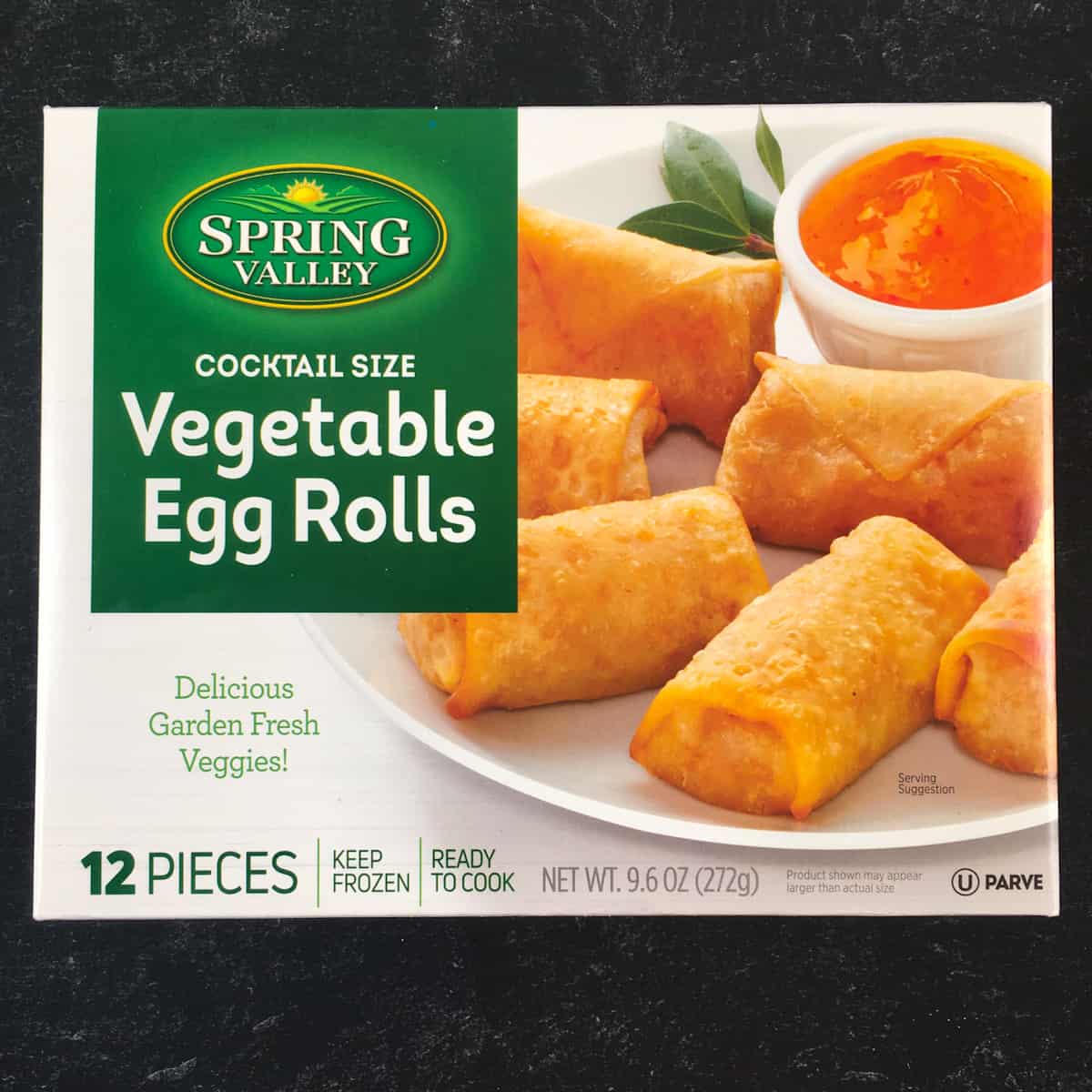
I like to serve sweet chili sauce or keto peanut sauce with egg rolls. You could also use sweet and sour sauce, soy sauce, Chinese hot mustard, or duck sauce for spring roll dipping sauce.
You can make air fryer spring rolls in a Ninja Foodi, Philips, Nuwave, Pampered Chef, Kalorik, Actifry, Instant Pot Vortex, Cosori, Breville, or another air fryer. The cooking times may need adjustment depending on the air fryer you use.
You should also have an instant read thermometer on hand to check for doneness. Most frozen spring rolls and frozen egg rolls should be cooked to a safe temp of 165F (74C). This includes spring rolls with vegetable fillings in addition to meat and poultry fillings.
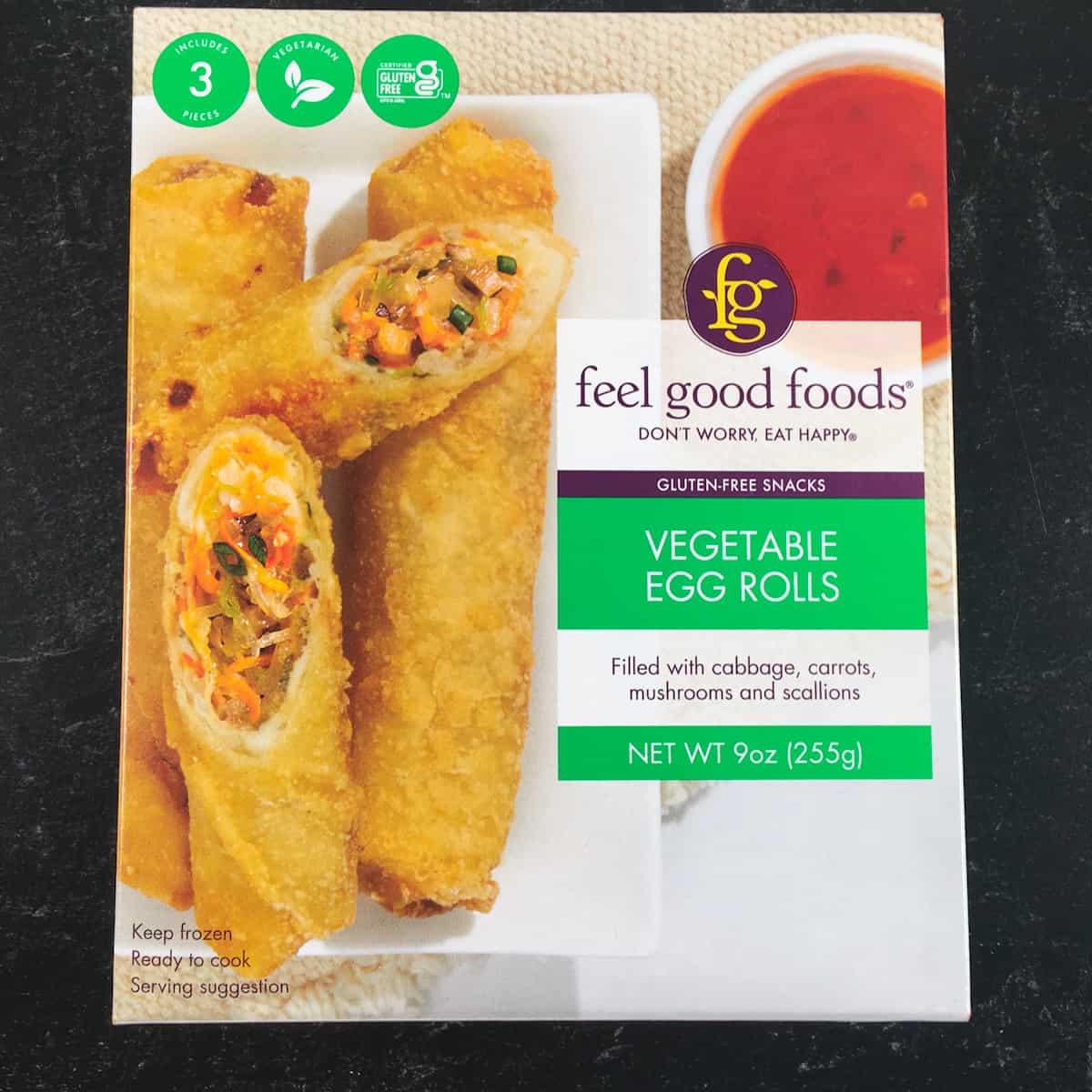
➕ How to Make Frozen Spring Rolls (Air Fryer)
Preheat the air fryer to 400F (200C) for 5 minutes.
Carefully place the frozen spring rolls on a hot air fryer tray or in the air fryer basket. Cook them in one layer, this gives them space to crisp on all sides and cook through. I was able to fit the entire box of spring rolls on my air fryer tray.
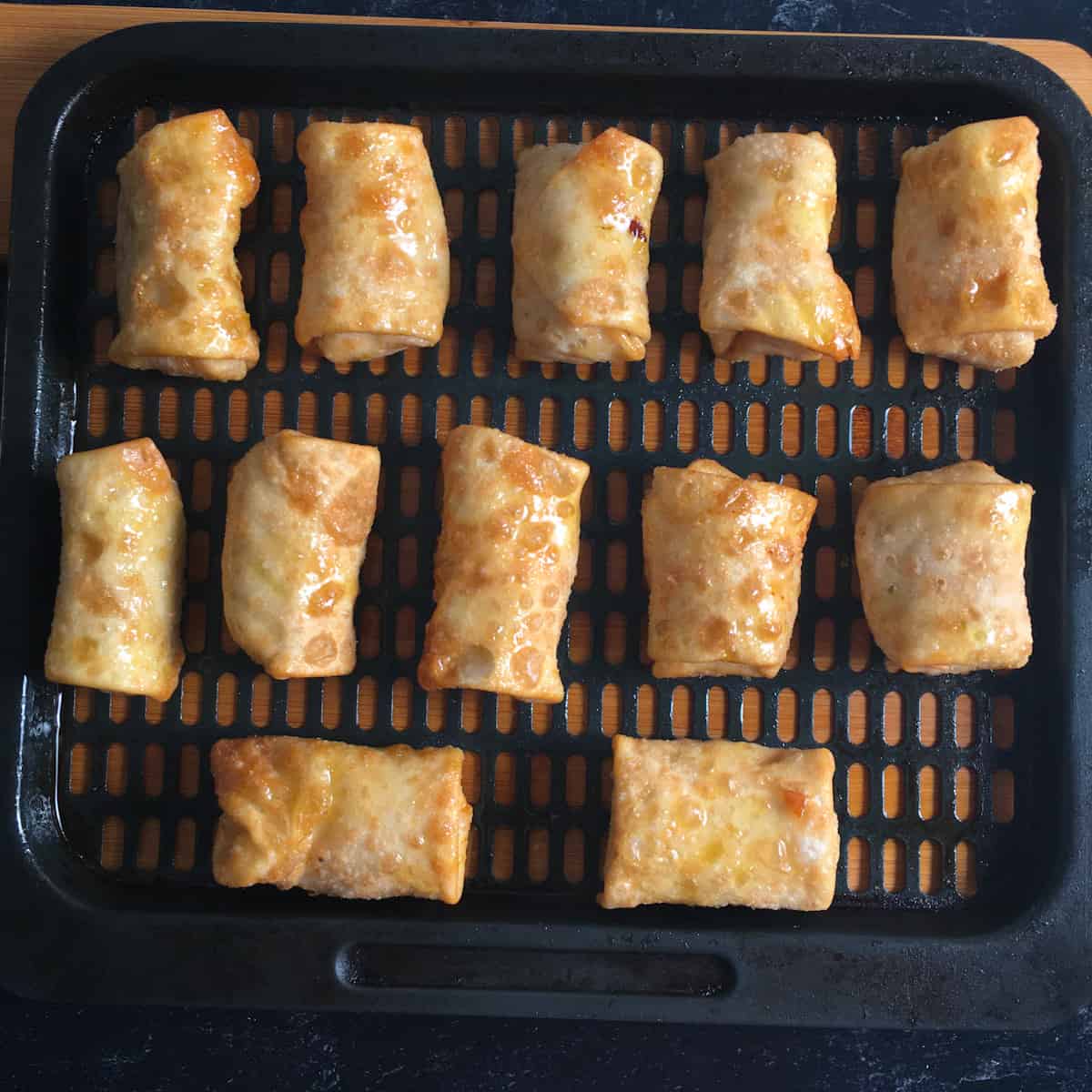
Mist them with cooking spray. If you have an air fryer oven, place the tray in the top rack position (closest to the heating element).
⏲️ How long to cook mini spring rolls in air fryer?
What is the air fryer frozen spring rolls time? What temperature to air fry spring rolls?
Air fry frozen spring rolls for a total of 7-8 minutes in an air fryer preheated to 400 degrees Fahrenheit (200C). Flip the spring rolls halfway through cooking time, misting them with more oil if they look dry.
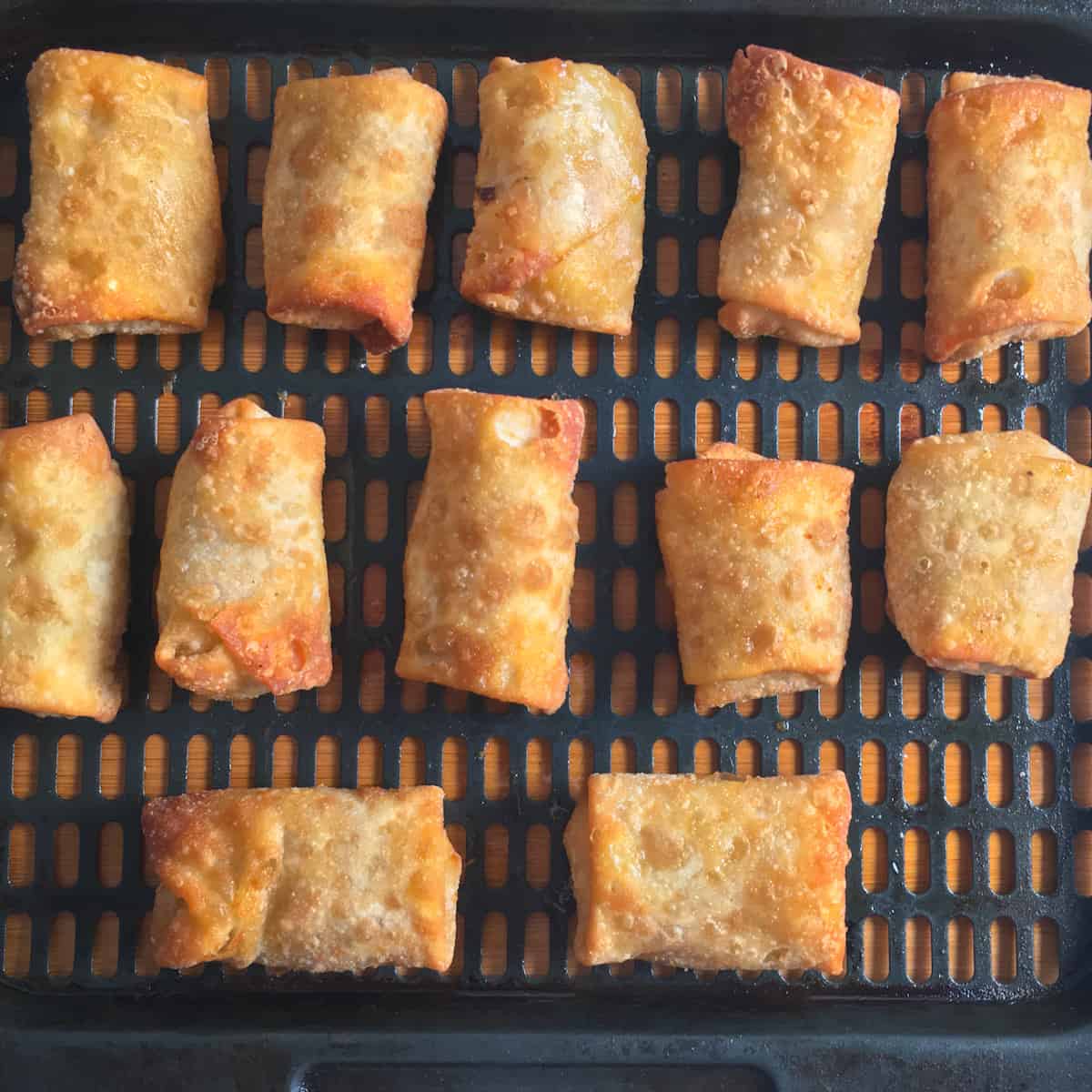
How to know when spring rolls are done?
After cooking, you can check to ensure they reached a minimum safe temp of 165F (74C) with a meat thermometer. Add additional cooking time if needed. This is especially important if the spring rolls have a meat or poultry filling.
How to Reheat Spring Rolls in Air Fryer
To reheat leftover spring rolls, air fry at 350F (177C) for 3 minutes. You don’t have to preheat the air fryer first. Use the top rack position if you have an air fryer oven.
It’s best to make spring rolls fresh, only air frying what you’re going to eat. That said, you can keep leftover cooked spring rolls in the fridge in an airtight container for up to 2-3 days. You can also reheat spring rolls in the microwave, but they will lose their crispy texture.
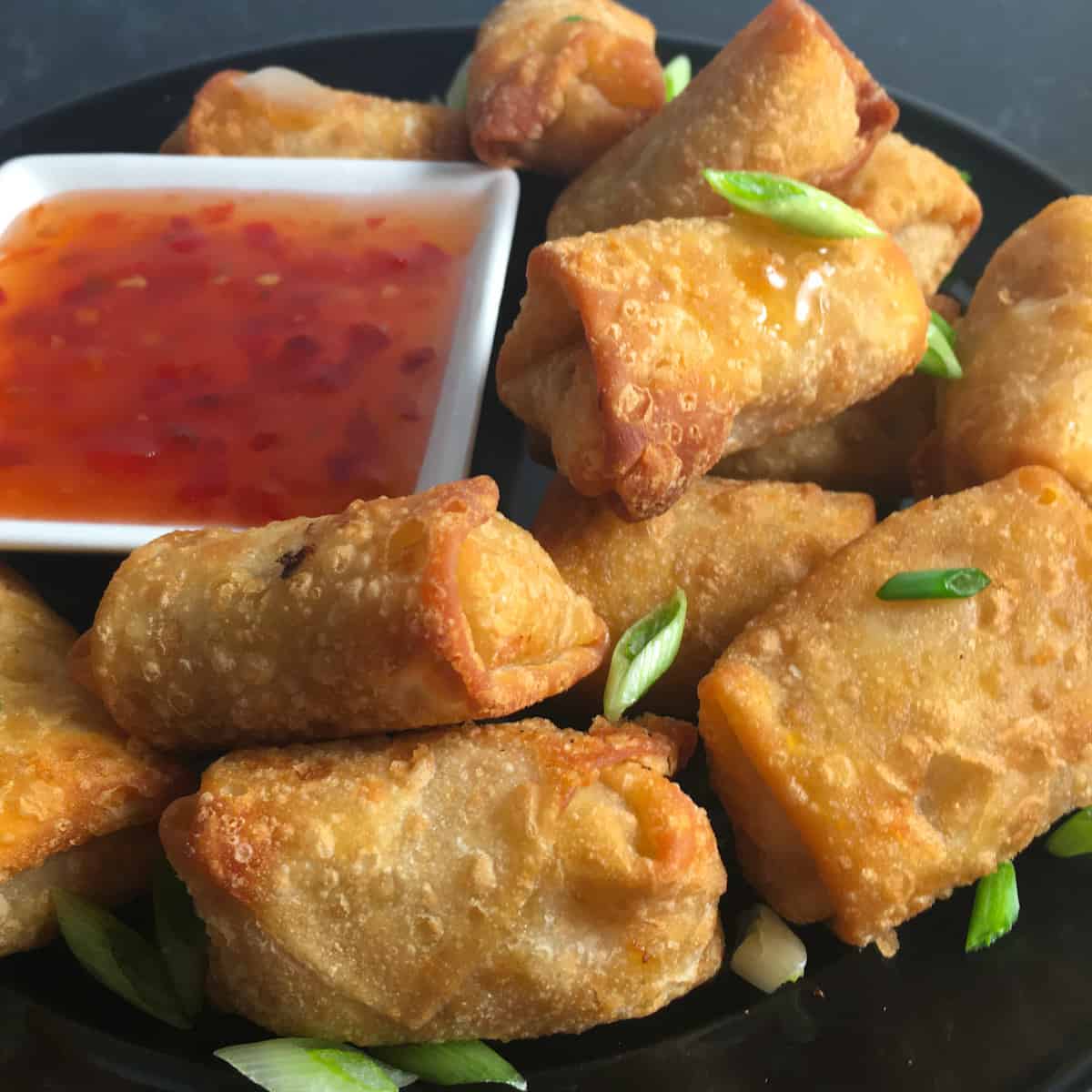
💭 Are frozen spring rolls healthy?
In terms of general nutrition, air fryer egg rolls are not the best choice. Frozen spring rolls from the store are an ultra-processed food that typically contains a lot of white flour. Additionally, they are often fried, making them a sub-optimal choice for weight loss.
Some frozen spring rolls are high in sodium and fat, though not all are. Check the nutrition label of the product you’re buying to make sure it fits your dietary needs.
IMVHO, homemade fresh spring rolls always win out compared to deep-fried spring rolls and egg rolls. There’s something about the colors and textures of a fresh spring roll that always draws me in. If this sounds good to you too, don’t miss the healthy spring rolls recipe in the recipe card below!
👨🏾🍳 Other Air Fryer Appetizer Recipes
Still hungry? Here are a few more ideas for appetizers in the air fryer:
- Air Fryer Pot Stickers
- Keto Mozzarella Sticks (Air Fryer)
- Air Fried Chicken Wings
- Ore Ida Tater Tots (Air Fryer)
- Totino's Pizza Rolls (Air Fryer)
Don’t miss our collection of Best Frozen Foods for the Air Fryer as well!
📖 Recipe Card
Watch How to Make It!
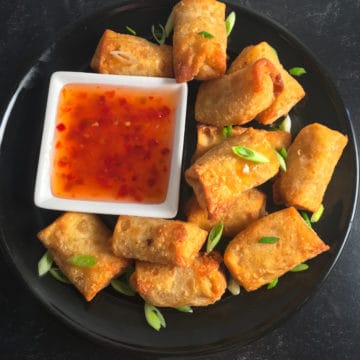
Frozen Spring Rolls in Air Fryer (Ling Ling Mini Spring Rolls)
Ingredients
- 1 package frozen spring rolls
- cooking oil spray (non-aerosol)
- dipping sauce of choice (optional)
Instructions
- Preheat the air fryer to 400°F (200°C) for 5 minutes.
- Carefully place the frozen spring rolls on a hot air fryer tray or in the air fryer basket. Cook them in one layer, this gives them space to crisp on all sides and cook through. I was able to fit the entire box of spring rolls on my air fryer tray.
- Mist the spring rolls with cooking spray. If you have an air fryer oven, place the tray in the top rack position (closest to the heating element).
- Air fry frozen spring rolls for a total of 7-8 minutes in an air fryer preheated to 400°F (200°C). Flip the spring rolls halfway through cooking time, misting them with more oil if they look dry.
- After cooking, you can check to ensure they reached a minimum safe temp of 165°F (74°C) with a meat thermometer. Add additional cooking time if needed. Serve with your favorite dipping sauce.
Equipment
Notes
💭 Expert Tips from Dietitian Summer Yule
This is a level 3 recipe (weight maintenance and active lifestyles). The calories in air fried spring rolls depends on the brand that you use. Here is the nutrition information for some popular spring roll brands (per serving, as listed on the packaging):| Brand | Calories | Net Carbs (g) | Protein (g) |
| Ling Ling Mini Vegetable Spring Rolls | 230 | 23 | 3 |
|
Pagoda spring rolls (vegetable) |
130 | 19 | 3 |
|
Trader Joe’s spring rolls (vegetable) |
90 | 7 | 2 |
|
Trader Joe’s spring rolls (chicken) |
100 | 9 | 5 |
|
Minh Egg Rolls (pork & vegetable) |
190 | 18 | 6 |
|
SeaPak Shrimp Spring Rolls |
170 | 16 | 4 |
|
Marathon Spring Rolls |
243 | 24 | 6.2 |
| Spring Valley Vegetable Spring Rolls | 170 | 23 | 4 |
| Feel Good Foods Vegetable Egg Rolls | 100 | 19 | 2 |
|
Chung’s Vegetable Spring Rolls |
200 | 24 | 7 |
Homemade Spring Rolls Recipe
- 7 rice paper wrappers
- 1.4 ounces rice vermicelli, rehydrated (40 grams)
- 8 ounces medium shrimp, tail-off, peeled, cooked (227 grams)
- 2 medium carrots, cut into matchsticks
- 1 cucumber, cut into matchsticks (9.5 ounces/269 grams)
- 25-30 fresh basil leaves
- 25-30 fresh mint leaves
- keto peanut sauce
To make spring rolls:
- Have all of your ingredients prepped and ready before you begin assembling the spring rolls. Cook the vermicelli according to the package directions. You should also cook the shrimp, cut the carrots and cucumber, and wash and dry the herbs. Fill a bowl with warm water, but don't soak the rice paper yet.
- Find a non-stick surface to assemble your spring rolls. I highly recommend using a sushi mat.
- Soak your first rice paper in the bowl of water for the length of time specified on the package. Mine needed to soak for five seconds. Only soak one piece of rice paper at a time, right before you plan to fill it.
- Lay the rice paper out on the sushi mat and layer the ingredients in this order: 3-4 shrimp, 1/7 of the vermicelli, 1/7 of the carrots and cucumbers, and 3-4 leaves each of the basil and mint.
- Fold the top and bottom of the rice paper inward to cover some of the filling. Now tightly fold the right side of the wrap over the filling. Finally, tuck any loose filling firmly into the wrapper and fold the final side over. (Watch the video below to see how the spring rolls are filled and wrapped closed.)
- Repeat for the remaining six spring rolls. If your rice paper tears too easily, try soaking the rice paper for less time. It should be flexible but still have some firmness to it. Use a double layer of rice paper if you've accidentally soaked it for too long and it has become fragile.
- Serve the spring rolls with the peanut sauce. Enjoy!
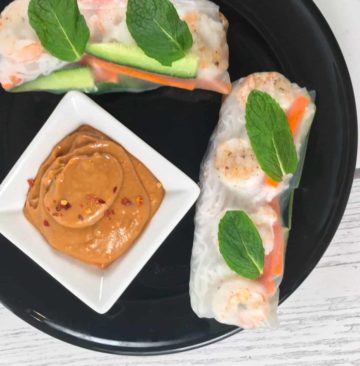 These are similar to a popular appetizer from the Cheesecake Factory. If you’re looking to lower the calories/carbs, substitute the rice vermicelli for shirataki noodles. Marinated tofu would be a nice alternative to the shrimp if you want a vegetarian variation.
Nutrition information is for four Spring Valley Veggie Rolls (cocktail size) without dip. Nutrition info will vary depending on the brand of spring rolls or egg rolls, the flavor, and your portion size.
These are similar to a popular appetizer from the Cheesecake Factory. If you’re looking to lower the calories/carbs, substitute the rice vermicelli for shirataki noodles. Marinated tofu would be a nice alternative to the shrimp if you want a vegetarian variation.
Nutrition information is for four Spring Valley Veggie Rolls (cocktail size) without dip. Nutrition info will vary depending on the brand of spring rolls or egg rolls, the flavor, and your portion size.
nutrition info disclaimer
All recipes on this website may or may not be appropriate for you, depending on your medical needs and personal preferences. Consult with a registered dietitian or your physician if you need help determining the dietary pattern that may be best for you.
The nutrition information is an estimate provided as a courtesy. It will differ depending on the specific brands and ingredients that you use. Calorie information on food labels may be inaccurate, so please don't sweat the numbers too much.
"To taste" means to your preferences, which may have to be visual to follow food safety rules. Please don't eat undercooked food x
Nutrition
FAQs
How to cook frozen spring rolls in oven?
Preheat oven to 400F (200C). Place the frozen spring rolls in a baking pan in a single layer. Bake for 8-10 minutes, until a safe internal temp of 165F (74C) is reached. Large frozen egg rolls and spring rolls can take up to 20-24 minutes.
How to fry frozen spring rolls?
To deep fry frozen spring rolls, preheat the deep fryer to 375F (191C). Deep fry frozen spring rolls for 4-6 minutes, until they reach an internal temp of 165F (74C). Blot spring rolls with paper towels to remove excess oil before serving.
What are the best frozen spring rolls?
IMVHO the best frozen spring rolls are the ones you enjoy that also fit your budget and dietary needs. Frozen spring rolls aren’t the most healthy or nutritious option out there. If I’m having a treat, my priority is that it is enjoyable.
Are air fryer spring rolls vegan?
Many air fryer spring rolls and egg rolls contain egg, and are not vegan. Ling Ling mini vegetable spring rolls at BJ’s are frozen vegan spring rolls. Lucky Foods has vegan spring rolls as well as gluten-free options. Check the label of the product you’re buying for the current nutrition info.
Why aren’t my spring rolls cooked through?
Some factors that impact spring roll cooking time include the size of the spring rolls, the air fryer you use, and whether you preheated the air fryer. This air fryer recipe is for thin, small spring rolls or egg rolls in a preheated air fryer.
Join our community! Subscribe for all of the latest and greatest recipes, and follow me on Facebook, Pinterest, Instagram, and YouTube!

Hello! I'm Summer, a registered dietitian and home chef who loves to cook, eat, and create high quality content for you! Every recipe on this site has been tested by me to help ensure your success in the kitchen. All eaters are welcome here 🙂


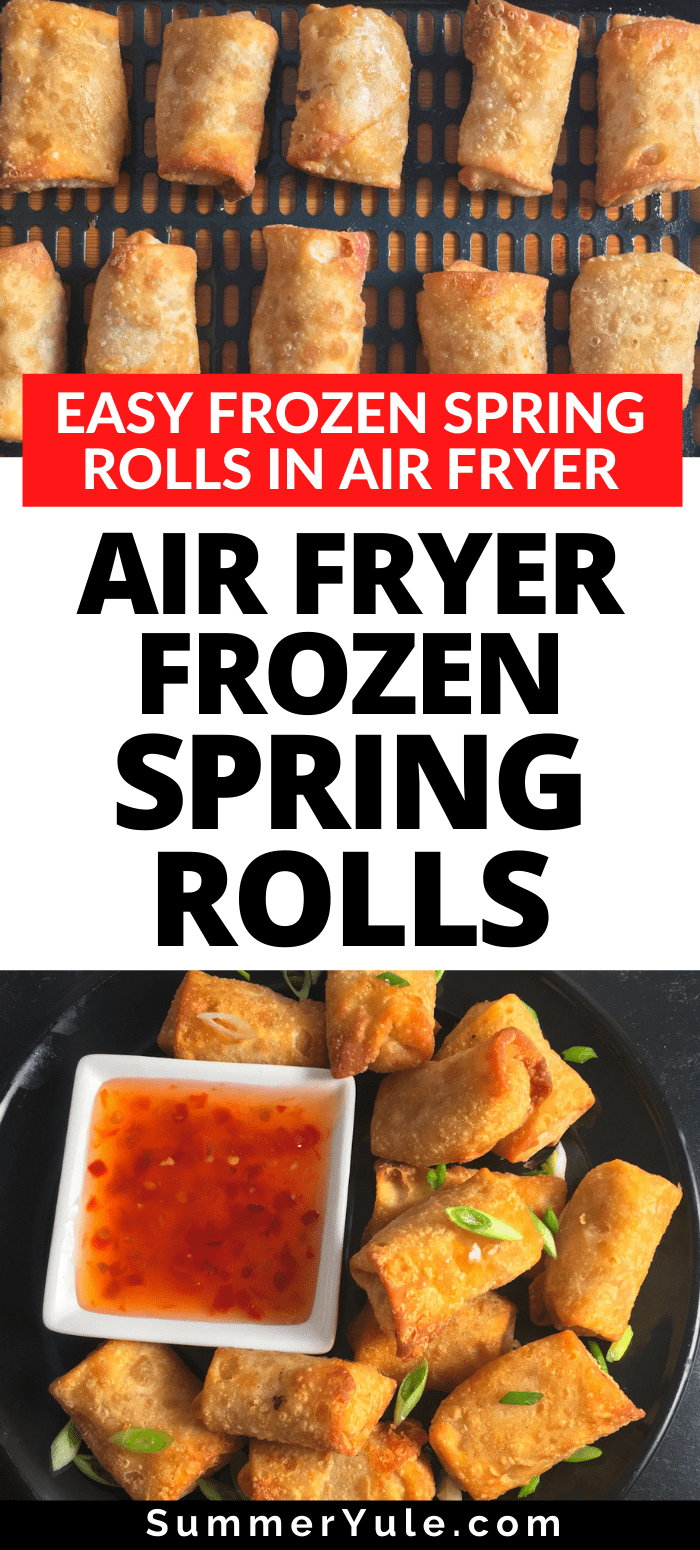
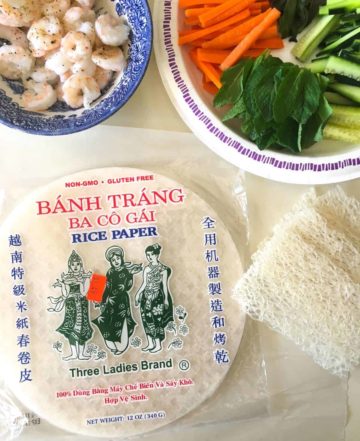
Terrified Amateur says
Brilliant, Summer! Spring rolls/summer rolls first captivated me when I indulged a decade ago at a Vietnamese restaurant in Arlington, VA. I bounded home "like a man obsessed," vowing to learn how to make them.
Your valuable article has intelligence that took me months of trial and error to gain. And then some!
One thing I did learn is that keeping the wrappers beneath a soaked dish towel maintains their moistness, and makes them (somewhat) more workable.
The freshness, and skipping the oven, are especially appealing now, as we in the Northeast have moved from early March to early August in fewer than two weeks.
Cool (literally), Summer!
Summer Yule says
They are a bit of work but well worth it, at least in my book! I think the first time I had them may have been in a restaurant as well.
I love the idea of keeping them under the wet dishtowel. I've been doing them one at a time all of these years. I'll try it your way the next time I make them!
Brian Hardin says
Love all the tips in this post! From assembling the spring rolls to alternative ingredients, it’s a boatload of useful information! Thanks for sharing!
Summer Yule says
Thank you! It's definitely a light meal or appetizer that can work well with many different modifications!